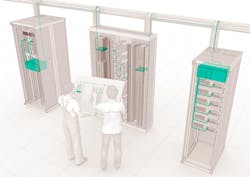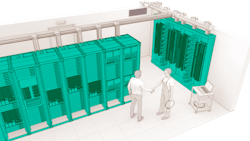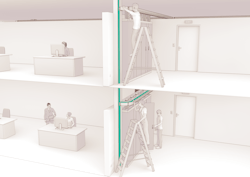Structured cabling solutions are key to addressing increasing demands on data centers
By Andreas Sila, Huber + Suhner
As the transition to a digital world continues, the pressure is on for data centers to meet the increased connectivity challenges this transition brings. Data centers must be scalable, faster and more efficient, which is driving the development of fiber-optic cable management systems. The Internet of Things is creating unprecedented demand on fixed networks, while the rise in cloud computing traffic, content delivery networks and edge computing are also having a significant impact. These are generating more data than ever before, putting businesses under extreme pressure to have the right solutions in their data center to cope with the demand. With the ever-changing environments, data center operators must be investing in technology that will grow alongside them.
The main focus is on revenue-generating equipment, so it is no surprise that the supportive, yet critical, cable management systems that are in play in the background often can be overlooked. But to address and overcome the challenges that operators are facing in terms of space, efficiency and profitability, these systems should not be an afterthought.
Early considerations
The data center environment is changing rapidly and there is extreme pressure for facilities to run seamlessly, as any downtime or human error can come at a huge cost. With some operators wary of moving fibers and causing damage, others are focusing on revenue-generating equipment. Difficulty accessing fibers, costs, and lack of resources are other common issues that data center operators are currently facing.
When implementing the principles of the structured cabling approach, it is important to adhere to national or international standards, such as TIA-942-B, EN 50173-5, or IEC 11801-5. Of course, not everyone has the in-depth expertise that is required. Therefore, it is important to have a strong partner to help guide operators to the most suitable structured cabling solution for their data center, as there is no “one solution fits all.”
Different fiber management systems are suitable for different environments. These include the main distribution area, zone distribution area, horizontal or intermediate distribution area, equipment distribution area, external network interfaces, and building entrance facility as well as all the cables and relevant connectivity. When it comes to making this decision, identifying the most suitable solution for a data center depends on a range of factors.The first step for operators must be to develop a structured cabling strategy. This approach takes into consideration the current business needs, as well as future demands too, to ensure any solution meets the relevant criteria. Getting the strategy right will save time and costs later on.
Industry challenges
The typical lifecycle of a structured cabling system is between 7 to 10 years, but during this time networking technologies may evolve several times. To save time, resources and costs, operators should look at implementing a properly designed system that will serve modern technologies and be capable of supporting future applications.
For the majority of operators, revenue-generating equipment is the priority, so space is a critical factor that must be considered when selecting a fiber management solution. If you do not have much space to work with, a solution that takes up as little space as possible is vital. However, maximizing space cannot compromise performance, cost, accessibility, or reliability, with many solutions in the market offering some of these benefits, but at the expense of others. To overcome space issues, a high-density solution is required that provides excellent organizational support for cable systems, as more fibers can be stored in a smaller space, leaving more room for the active, revenue-generating equipment.
Accessibility is another key consideration when it comes to fiber management. As data centers and the number of fibers they contain grow, any movement or adjustment of the cables open up the risk, and associated costs, of human error. There are varying levels of accessibility provided by cable management solutions in the market, including rear, side and front access. Depending on the chosen connectivity solution, such as splice, patch or transition, there could be certain cable management solutions that are more suitable for a particular data center than others.
A structured cabling solution can give complete peace of mind that once implemented, operators can be confident that it can be left alone to work effectively. However, flexibility is important in fast-moving environments, and changes must be able to be actioned where necessary. By having a solution in place that instils confidence, valuable resources can be spent elsewhere in the business, where it is truly needed. This should also be a factor when it comes to the installation of a fiber management solution, as a system that can be installed quickly and effectively, with little or no specialized staff, helps to keep costs low and resources at a minimum.
Make white space work harder
For colocation or multi-tenant operators, it is important that the chosen solution for the white space is seamlessly connected to the meet-me room (MMR) and the fiber backbone. If the end goal is to build the foundation for an efficient data center that maximizes uptime, you must first comply with standards and allow for an easy upgrade path as the business evolves. The MMR should enable efficient crossconnects and the overall appearance should invoke trust and pride with a pristine and organized entry point to connectivity. The fiber backbone should be preplanned to easily scale up to meet growing needs.
While connectivity is of course important, colocation operators also provide other services that must be taken into account. These include providing access to cloud resources, building structured cabling systems, providing network services, and renting out hardware resources. A seamless, integrated structured cabling strategy using a comprehensive solution portfolio will ensure that all connectivity and service requirements can be met at all times—now and in the years to come.
Addressing current and future needs
Data center operators are looking for solutions that meet the needs of today, paying only for what is required at a given moment. Yet to avoid having to start the process all over again when demands change, operators should consider scalable solutions that offer upgrade options when needed. Operating in a fast-moving environment can be extremely challenging, and often costly, so implementing a cable management system that can grow alongside the business is key.
By only paying for what is needed in the moment and upgrading when the time is right, operators can negate the need to invest up front. This means that costs can be kept to a minimum, ensuring more capital and resources can be invested in the products and services that drive revenue. Every need is different and when a standard approach is not sufficient, a customized solution should be considered. By working with a provider that offers the flexibility to make even complex modifications, a cable management solution can be designed that meets the exact requirements.A solution that ticks all the boxes
With so many factors that must be considered when it comes to cable management solutions, operators need a structured solution that overcomes the key challenges when it comes to space, efficiency, resources, accessibility and profitability. Innovative systems can ensure that operators are implementing the right solution, for the right specifications, for the right location. A high-density, reliable, easy-to-manage and space-optimizing solution will drive performance, while keeping costs and human error to a minimum.
By working with a specialized expert, data center operators will receive the right support when looking to implement a structured cabling solution. In collaboration with the right partner, operators can have confidence that the chosen system meets the needs of the business, allows for hassle-free operations and will grow alongside them. The digital demands placed on data centers means that connectivity challenges will continue to become apparent, and having the right system to manage this will be key to success.
Andreas Sila is vice president market management, data center, with Huber + Suhner.



